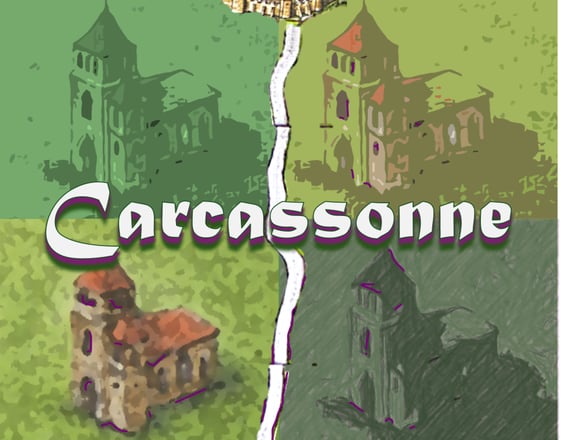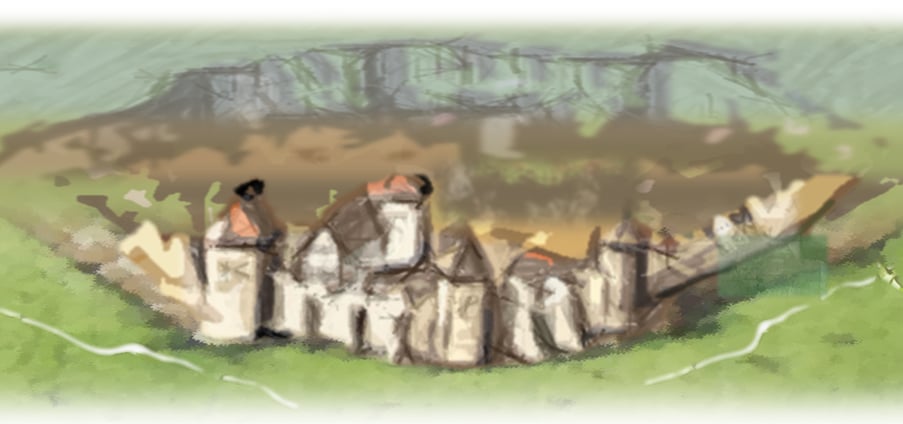
Carcassonne Still Hits my 'Onne' Button
A review of Carcassonne
Chris Sanderson


Let's just momentarily wind the clock back, say, 30 years, to the pre-Carcassonnian era.
Imagine you're showing Carcassonne in prototype form to a prospective game publisher.
You open the bag (no box designed yet of course) and start pulling out the tiles. And the publisher guy clears his throat and asks where the gameboard is.
“Good question,” you say, trying not to sound patronizing. “It's - er, here, in the tiles”.
The guy frowns doubtfully as he watches you placing tiles together. “You mean, you have to make the gameboard yourself?”
“Sure, you take turns placing tiles to create a map.”
The guy nods slowly. “And then when you've made it, how do you play?”
Now it's your turn to frown. “No, that's the game: you place the tiles to get points, then see who won.”
The game publisher gives you a sharp glance, expecting to catch you smirking. You're not.
“So you're telling me that the whole game is just making up the gameboard?” he says. “What kind of a dumb game is that?”
“Actually,” you say quietly, “it's kind of revolutionary, don't you think?”
Revolutionary ... Now, a quarter of a century on, does Carcassonne seem quite so revolutionary?
We've got used to the concept, haven't we? A boardgame where the game is making the board. DIY gaming, nothing added except a bunch of meeples.
And a whole load of layers floating out there somewhere in the tile arrangements.
“The game, you see, is in the connections between the tiles,” you’d explain to the publisher guy. “You're setting up a counterpoint between the city focal points and the surrounding spread of farmlands, between the linear roads and the monasteriess. The context itself is the game.”
“Context and Counterpoint?” he’d mutter. “Sounds more like a Jane Austen novel than a boardgame.”


Since those early days, of course, tile-laying has become a genre in its own right. Few would question it now. But for some, Carcassonne has grown stale - a bit too soft an option, perhaps, for modern tastes?
Not for me. I won't leave it behind. I refuse! I'm designing medieval France, for goodness' sake! I'm spawning walnut cities, making them sprawl and twist back on themselves or even have holes in the middle.
I can claim them, hijack them, bend them and distort them in whatever direction I wish.
Should I take that for granted? Never!
Or what about the roads? Reaching wherever you (and they) want, defining and shaping landscapes like trenched frontiers, even looping to trap opponent farmers. A soft option? Hardly! While cities form power-hub networks across the farmlands, roads are the defining limits of both the networks and the farmlands.
Or what about monasteries? Gently nestling in vacant lands, they give sense to pockets of farmland, sometimes stealing into the centre of nowhere and making it the centre of somewhere.
Or those farms? The existential space around everything else, amorphous, the very air you breathe.
All of this hidden somewhere in a load of square tiles.
No, I won't move on. Carcassonne brought me the wonders of medieval cartography turned freestyle. And being a medieval architect still has no limits. There are dimensions yet to be explored as you assume the multiple role of a boundary-drawer/farm-expander/city-builder/monastery-encloser. And those meeples are still waiting to be assigned on missions to claim, hinder, clinch or invest. The fun is not knowing when or if they'll come back again. They're on blind missions, incommunicado, left to fend for themselves.


And you? You're the king of elasticity, bending landscapes and bloating cities into random shapes. Okay, so urban design was never a strong point here, nor landscape distribution. But did that ever matter in those heady days of first love?
Maybe your passion cooled when you discovered the meaner side to the game. It came as a surprise to find hijacking and sequestering creeping into what had once been an innocent, free Carcassonne medieval world. Instead, it started feeling something like the product of Soviet Russia's Five-Year Plan. The only things missing were the gun towers on the city walls and the barbed wire along the roads.
But there's a remedy there too. You can choose the game mood.
Yes, the great thing about Carcassonne is you can make it 'Carcass' or 'Onne'. You can kill it with meanness or light it up with kindness. You choose.
Or no, better let your partner choose, if you're playing with your ‘other half’. Don't want any collateral damage, relationship-wise, or you'll definitely get 'Carcassoffe'.
But in the end, you name the game. Karkazónneh? Carkasown? Take whatever slant on it you want. The game is that open - so open, it's more like a charter, a constitution. And the only limitation is you're writing it in collaboration with your opponents.
Which can be quite a major limitation, actually, if you’re looking for uninterrupted peace and harmony.
Still, there are dimensions here to be explored, in kindness or in meanness, till paths do us part. And don't be put off by the faded, greeny beigeness of it all. There's bite in the old Carky yet if you're a sucker for:
* shaping the sprawl
* annexing zones
* destabilizing cities
* sabotaging rival lands
And if all of this no longer appeals, I can't recommend strongly enough the official solo variant. Being three players at once in co-op mode just hits my Onne button. And yours?
BoardGameGeek review here.
Hi, I am Chris Sanderson, an Englishman living near Madrid, Spain. Please send me your comments by email, or in BoardGameGeek through the links at the end of each game review.
© 2025. All rights reserved.